First Look: Viewsonic G Tablet and Tegra 2 Performance Preview
by Vivek Gowri on December 9, 2010 3:04 AM ESTViewsonic G Tablet - Tegra 2 Performance
Let’s get to the really important question - how does Tegra 2 as an SoC stack up against Snapdragon and Hummingbird? We’ll start with the CPU side first, so that we can take a good look at how the Cortex A9 stacks up against A8 and Scorpion. For Hummingbird, we’ll be using the Froyo-based Galaxy Tab that we have in our labs (review forthcoming) since it’s the only Galaxy device that we have available with 2.2 installed. We’ve also got the T-Mobile G2, running an 800MHz 2nd generation Snapdragon along with the Nexus One and EVO 4G with the original 1GHz Snapdragon. We tossed in the 1GHz OMAP3-based Droid 2 just for kicks.
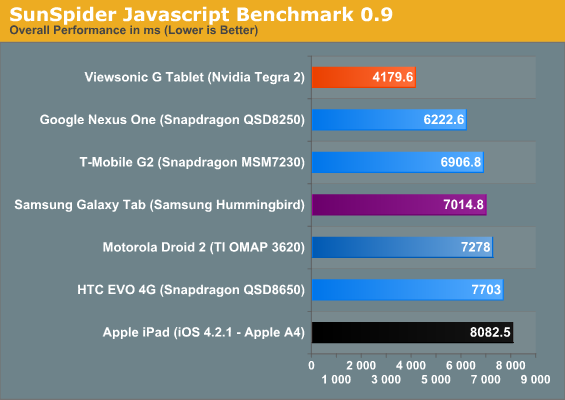
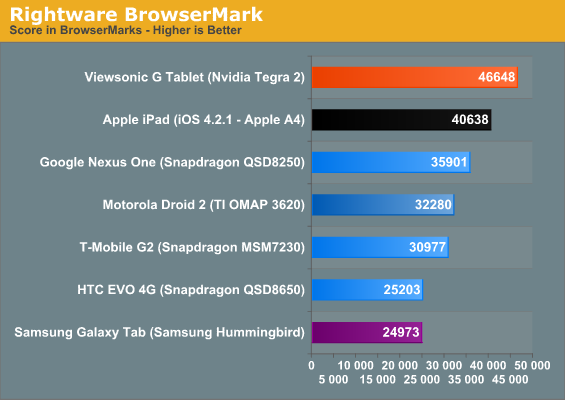
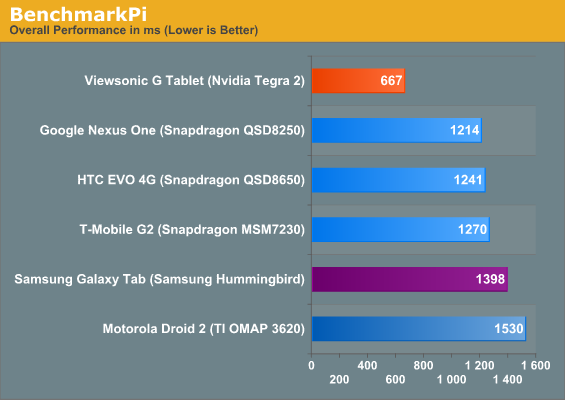
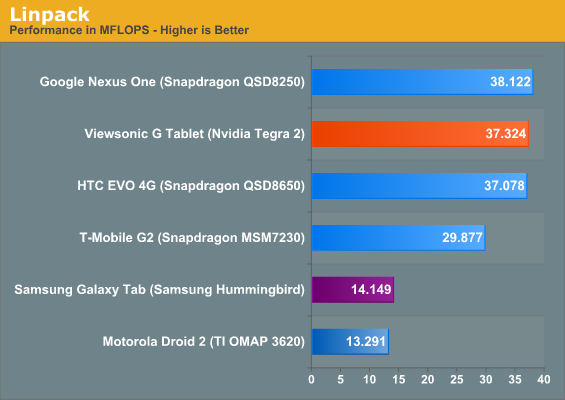
So how does the A9 fare? Impressively. Anand said in his A9 intro to expect 30-100% performance improvements over A8-based designs, and that’s exactly what we see. Comparing the Viewsonic G Tablet to the Galaxy Tab, we see a 75% improvement in JavaScript performance and a 2x performance increase across the board in the rest of our computing benchmarks. We saw roughly the same performance increases when compared to the Droid 2. So, that’s a pretty good summary of A9 performance versus the A8. The only thing we need to note here is that some of our benchmarks appear to be single threaded, so we don’t get the full effect of having the dual-core A9. Multitasking usage models can see a bigger impact from the two cores, not to mention the power savings having two cores sharing a workload at lower frequency/voltage states can offer.
Now, comparing the A9 to the 45nm and 65nm Scorpion cores is more interesting. Qualcomm ensured that Scorpion had really good floating point performance along with some elements of speculative execution, so Linpack performance ends up being similar to A9. Scorpion had slightly faster JavaScript performance than A8, but A9 still ends up being roughly 50% faster. BenchmarkPi is 83% faster on the A9 than Snapdragon, but the BrowserMark result is pretty variable. The Nexus One is roughly 50% faster than the EVO 4G with the same processor, which is probably due to the Sense UI overlay on the EVO instead of the completely stock UI on the Nexus One. The A9 result is roughly 90% more than that of the EVO, while only 30% faster than the Nexus One. So overall, we can say that A9 is significantly faster than Snapdragon as well, but how much faster is kind of across the board and very dependant on the task.
The move to dual ARM Cortex A9s is going to be a significant step forward in smartphone and tablet performance next year. In fact, the next three years will be full of significant SoC performance gains eventually culminating in some very, very fast PC-like smartphones.
So now with the A9 part out of the way, let’s look at the graphics side of Tegra 2. NVIDIA hasn’t given too much information about the GeForce ULP other than saying it’s the same OpenGL ES 2.0-supporting architecture as the original Tegra GPU with higher performance. NVIDIA claims a 2-3x performance increase stemming from higher clock speeds and more memory bandwidth.
I’ve heard rumours that the GeForce ULP is actually slower than the PowerVR SGX 540 in Hummingbird. To see whether that’s actually true, I put the Viewsonic through our two graphics benchmarks. The problem is, we can’t compare the results to any of our smartphones due to the change in resolution, so the only real device we have for comparison is the Galaxy Tab. This is fine, since SGX 540 is really what we want to compare GeForce ULP with.

So, the benchmarks. Neocore gives us some weird results, with the Galaxy Tab hitting the same 54 fps cap we’ve seen before on the Galaxy S smartphones, but Tegra 2 only managing 28.1 fps. Neocore is a Qualcomm benchmark and is likely optimized for tile based architectures, and not for NVIDIA's. A performance advantage here isn't unexpected.
12/20/2010 - Updated Graphics Benchmarks
Before we intially posted this article, I ran the Quake 3 demo on the Viewsonic G Tablet and the Samsung Galaxy Tab three times each. I ended up with 49.0, 48.2 and 49.9 fps on the Viewsonic, and 31.9, 32.2, and 32.1 fps on the Galaxy Tab. Run the averages, and you get 49.1 fps for the Viewsonic and 32.1 fps for the Galaxy. Based on some input from Imagination and other Galaxy Tab users, we decided to retest the Galaxy Tab, since our results were a good bit lower than what they were reporting.
And on re-running the Quake 3 benchmark, I got results in the 44.9 - 46.0 range. I ran it over 50 times trying to replicate the previous scores, but under no conditions (settings, background applications, etc) could I get anywhere near my previous result. I know for a fact that the settings were all correct and that there were no previously running applications, so I really have no idea why I got a framerate that low, much less why it was repeatable.
In addition to retesting Quake 3 on the Galaxy Tab, I also ran both slates through GLBenchmark 2.0, which we recently added to our benchmark suite. The combination of the two gave me enough reason to write up an update to our Tegra 2 performance preview from two weeks ago. I was also planning to compare Quadrant’s 3D graphics score, but I was unable to get the SlideME store working on the Viewsonic to download Quadrant Professional.
With the revised Quake 3 benchmarks, Tegra 2 has a slight 10% lead over the SGX 540, bringing it more in line with what we expected. Looking at our GLBenchmark 2.0 results, we can see that Tegra 2 has the lead here as well, though by a slightly larger margin. In GLBenchmark Pro, the Tegra 2 has a 30% lead over the Hummingbird, while in the more-demanding Egypt benchmark, the gap shrinks to 20.4%.
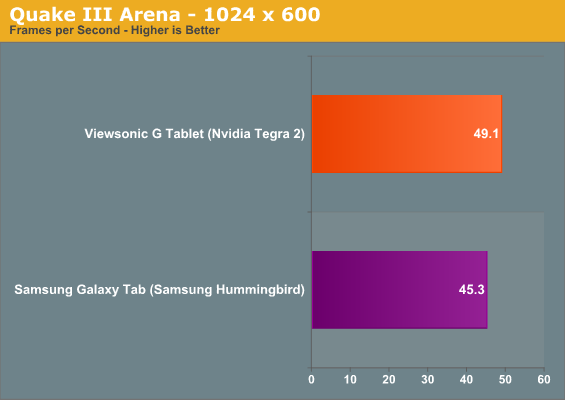
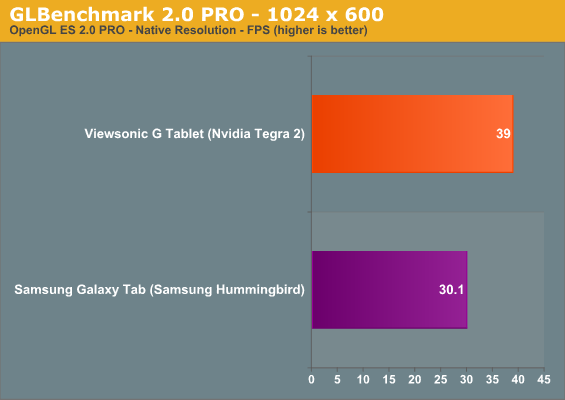

So while the performance difference isn’t nearly as dramatic as we originally thought, most of what we said before still holds true. It looks like Tegra 2 has the potential to be the best SoC for Android gaming, making it a really attractive platform for tablets. With all the rumours flying around about Google making Tegra 2 the reference platform for Honeycomb-based tablets, apparently we’re not the only ones who think so. The question is how well will it handle existing 3D content that's likely optimized for Qualcomm and Imagination Technologies GPUs.
We’ll take a more in-depth look at Tegra 2’s performance as well as power consumption in our full review of the Viewsonic G Tablet later this month, and hopefully by that time we can give you the Quadrant benchmarks as well. But for now, we can say that Tegra 2 is the most powerful SoC on the market at present and makes for a very capable tablet platform.










78 Comments
View All Comments
xipo - Thursday, December 9, 2010 - link
after looking the way the Google Nexus One performes with an old Snapdragon QSD8250, one can only wish there where a Google Nexus TAB :D that would be a mayor win... because clearly the hardware is worthless without proper software optimization.. so, you should update this charts as soon as the google nexus S comes out.Ben90 - Thursday, December 9, 2010 - link
If the Linpack algorithms are the same. An overclocked i7 system is over 1000 times faster than these tablets. Obviously you would expect an i7 system to be faster, but it just puts it into perspective.metafor - Thursday, December 9, 2010 - link
Linpack implementations on desktops also use Intel's optimized SSE library. A similar NEON implementation should show significant improvements.Also, the memory subsystem on desktops is ridiculously fast compared to a smartphone.
name99 - Thursday, December 9, 2010 - link
There is a NEON-optimized LINPACK as part of iOS 4.It would have been nice if someone had bothered to investigate this issue to get some numbers for it. If only there were some way to search the internet on this subject ... Oh wait...
There is a Linpack app on the iTunes store that is a very thin wrapper around the Apple code. Running it on my iPad, I get 38.67 LINPACK Mflops/s.
name99 - Thursday, December 9, 2010 - link
Actually I read the Linpack report incorrectly. The mean result (averaged over 50 runs) was around 41.8 Mflops/s. The number I reported was simply the result of the very last run.There was quite a bit of scatter in the results, with the fastest coming in at just under 50 Mflops/s. I'm not sure quite what is happening here --- the most obvious assumption is OS scheduling and interrupts, and that whatever timer is being used to calculate the results is tracking wall time, not process time.
metafor - Friday, December 10, 2010 - link
The comment was regarding scores on Android phones. Also, those are quite low if they truly take use of NEON. But the A8's FPU isn't known for speed.name99 - Friday, December 10, 2010 - link
Jesus dude, the article is titled First Look at Viewsonic TABLET.And regardless of how bad Apple's NEON LINPACK may be (it apparently matches Google's implementation in that they get comparable results on comparable hardware) the fact is the implementation exists, which is more than can be said for some phones.
Are you so desperate to hate Apple that you need to clutch at straws like this? There are plenty of real things to criticize in the iOS world without being just stupid.
metafor - Monday, December 13, 2010 - link
I believe you're the only one who's mentioned Apple.My comment was about Linpack on Android and how (since it runs on a VM), it doesn't utilize NEON. As you so pointed out, a native implementation on the same processor (Hummingbird) produces better results.
Still, the end results are quite low compared to what could be expected from the hardware, suggesting further software optimization is necessary before a comparison to the desktop.
Genx87 - Thursday, December 9, 2010 - link
It will be interesting to see how much power this consumes. I suspect the i7 system may consume 1000 times more power as well ;)synaesthetic - Monday, December 20, 2010 - link
Much more than 1000 times, actually. :)